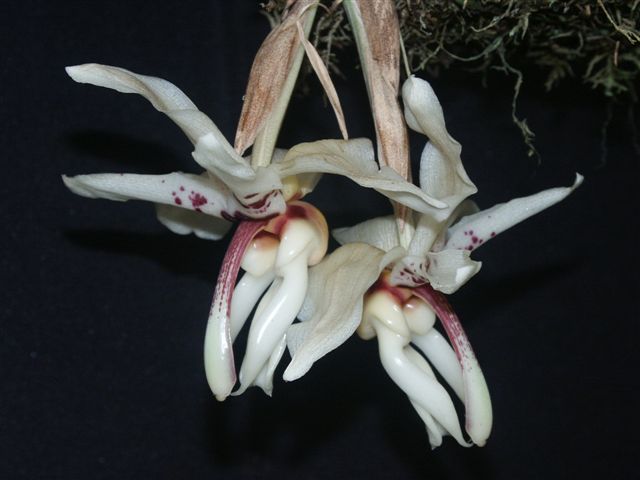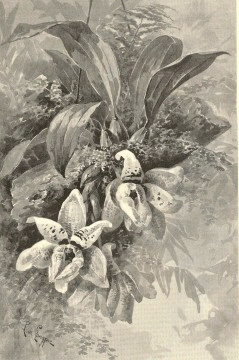
Stanhopea martiana
Bateman ex Lindley 1840
Native to Mexico
Edited 11 May 2007
© Nina Rach

This Mexican species was originally published in 1840 in the Botanical Register Misc. 50.
The photo at left was provided by Kelvin Bush, UK grower.

.
The image at right is an illustration of Stanhopea martiana published in Flore des serres et des jardins de l’Europe by Charles Lemaire and others, in the 1850's.
.
This species grows at an elevation of ____ m above sea level. It has been found in the Mexican states of ___ and ____.
Stanhopea martiana is very showy, but not very common in culture. It grows in intermediate to cool conditions.
A similar-appearing species is
Stanhopea hernandezii. Index Kewensis also lists Stanhopea martiana var. bicolor Lindl., published in Edward's Botanical Register 29: tab. 44. 1843.
Williams and Whitten (1999), working at the Univ. of Florida at Gainesville, noted that Stanhopea martiana is "morphologically similar to S. tigrina Bateman ex Lindley, but differing in floral fragrances" and "forms an independent clade."

.
.
This species has also been described in the literature as
Stanhopea velata Morren from Mexico but is now considered S. martiana. At left is a hand-colored lithograph of "Stanhopea velata" from: Annales de la Société royale d’Agriculture et de Botanique de Gand, Journal d’horticulture, by Charles Morren (ed.). Gand, etc., 1847
.
.
.

Stanhopea martiana 'Lee Fent' CHM/AOS (84 points)
Awarded on 6/19/1993 at the Great Plains Regional Monthly Judging, Oklahoma City, OK. [Awards Quarterly, vol. 25 (1), p. 27, color photo on p. 25]
Description:
"Two flowers and four buds on two inflorescence [ibid.], one inflorescence with open flowers and one with two fully expanded buds, 16 inflorescences beginning to mature; mature flowers are flat, fully opened, creamy white with definite burgundy spots on sepals and petals; petals with large burgundy blotches, darkening toward column; lip creamy white; column creamy white with numerous small burgundy spots; plant with 56 mature growths with 35 new growths growing in sphagnum moss in a 25-cm (10-inch) square wire basket.
Nat.spr. 13.0cm, 11.0cm vert; ds 3.5cm w, 7.5cm l; pet 2.2cm w, 6.0cm l; ls 4.0cm w, 8.0cm l; lip 3.0cm w, 5.5cm l. Exhibitor: by Max Thomson, Winfield, KS (930874)"
The image at right depicts a portion of the award slide.
.
Another award to this species is:
Stanhopea martiana 'Oaxaca' CBR/AOS
Awarded on 7/20/85 at the Great Lakes Regional Monthly Judging, Ann Arbor, MI [Awards Quarterly, vol. 17(2), p. 99; no picture]
Description:
"Two flowers back to back on one pendent inflorescence; flowers creamy white; sepals with burgundy maculations; petals with larger, darker burgundy maculations; lip mesochile and hypochile immaculate, epichile saccate with internal orange-yellow background and burgundy blush, column spotted with dark burgundy on creamy white; leaves coriaceous, lanceolate, margins undulate. Natural spread of flower 13.9 cm; dorsal sepal 3.2 cm wide, 7.2 cm long; petals 1.0 cm wide, 6.3 cm long; lateral sepals 4.9 cm wide, 7.6 cm long; lip 5.5 cm wide, 3.0 cm long. --
Exhibitor: Raymond McCullough, Livonia, MI (85-707)"
Hybrids:
There are three known primary hybrids utilizing Stanhopea martiana:
Stanhopea Bucmar (bucephalus x martiana), grown by Dick Hartley (Foxdale Orchids, UK);
Stanhopea Uli Paterny (oculata x martiana), registered in 1994 by H.J. Jung; and
Stanhopea Wolteriana (martiana x tigrina), registered in 1905 by P. Wolter.
References:
Kenneth J. Curry, Lorraine M. McDowell, Walter S. Judd, & William Louis Stern (May 1991) "Osmophores, Floral Features, and Systematics of Stanhopea (Orchidaceae)," in: American Journal of Botany 78(5): 610-623.
"The floral fragrance glands (osmophores) of 18 species of Stanhopea and Sievekingia were examined through a series of developmental studies at light and electron microscope levels including late bud stages through postanthesis." [Sievekingia; Stanhopea anfracta, annulata, candida, ecornuta, gibbosa, martiana, oculata, pulla, radiosa, ruckeri, saccata, shuttleworthii, tigrina, vasquezii, and wardii]
Link to abstract:
http://www.botany.org/ajb/00029122_di001922.php
Calaway H. Dodson (1963) "The Mexican Stanhopeas" in: American Orchid Society Bulletin 32(2): 115-129. [Stanhopea devoniensis, fregeana, intermedia, martiana, oculata, saccata, tigrina, wardii]
Barney Greer (Sept. 1998) The Astonishing Stanhopeas (the upside-down orchids). Sydney: Australian Orchid Foundation. 92 color pages, including 55 known species and five natural hybrids. [p.37: with color photo]
 Rudolf Jenny (Dec. 2003) "The Genus Stanhopea. Part 1: S. anfracta to S. napoensis," in: Caesiana no. 21, Supplement. 200 color photos, 160 p., Italian/English, covers 32 species.
Rudolf Jenny (Dec. 2003) "The Genus Stanhopea. Part 1: S. anfracta to S. napoensis," in: Caesiana no. 21, Supplement. 200 color photos, 160 p., Italian/English, covers 32 species.
Rudolf Jenny (Dec. 2003) "The Genus Stanhopea. Part 1: S. anfracta to S. napoensis," in: Caesiana no. 21, Supplement. 200 color photos, 160 p., Italian/English, covers 32 species.
George Kennedy (Sept.-Oct. 1975) "The Stanhopeas of Mexico," in: Orchid Digest 39(5): 178. [includes Stanhopea graveolens, hernandezii, maculosa, martiana, oculata, radiosa, saccata, tigrina]
Ray McCullough (10 March 1996) "Culture of Various Thin-Leafed Orchids," a Synopsis of Ray McCullough's talk at the Ann Arbor OS meeting.
[Houlettia tigrina; Stanhopea intermedia, S. graveolens, S. costaricensis, S. martiana, S. grandiflora, S. eburneum, S. oculata, S. wardii, S. ecornuta, S. connata, S. saccata, S. radiosa, S. tigrina]
Rogers McVaugh (28 June 1985) Flora Novo-Galiciana, A Descriptive Account of the Vascular Plants of Western Mexico, Vol. 16: Orchidaceae. Ann Arbor: The University of Michigan Press, pp. 343-344. [Stanhopea intermedia, maculosa, martiana, radiosa, plus discussion of doubtful species such as: oculata, saccata]
W.A. Stiles (1894) article in magazine, illustrated by Paul DeLongpre, 14pp. [Stanhopea martiana, Mexico, cream - white & purplish - crimson, full page illustration; also at right]
Peter Taylor (June 2000) "Selected Species: Stanhopea martiana" in: Orchids Australia 12(3): pp.??. Link to article:
www.orchidsaustralia.com/Stan_martiana.htm.
["Peter Taylor's regular page on species brings us this very striking orchid, with a superb photograph from the collection of David Banks. The flower is almost clown-like in appearance. As usual, Peter delves into the history of the species as well as its cultivation."]
Norris H. Williams and W. Mark Whitten (Aug. 1999) "Molecular phylogeny and floral fragrances of male euglossine bee-pollinated orchids: A study of Stanhopea (Orchidaceae)," in: Plant Species Biology 14(2): 129.
Links to Stanhopea martiana:
International Plant Names Index [IPNI],
www.ipni.org.
High-resolution photo of Stanhopea martiana, by Libor Jankovsky
Stanhopea martiana from the collection of the Botanical Gardens and Arboretum of Mendel University of Agriculture and Forestry Brno, Czech Republic.
Stanhopea Awards and
Stanhopea Hybrids [Nina Rach]
Artificial Hybrids of Stanhopea [Foxdale Orchids]
Las orquídeas y sus nombres










 Rudolf Jenny (Dec. 2003) "The Genus Stanhopea. Part 1: S. anfracta to S. napoensis," in: Caesiana no. 21, Supplement. 200 color photos, 160 p., Italian/English, covers 32 species.
Rudolf Jenny (Dec. 2003) "The Genus Stanhopea. Part 1: S. anfracta to S. napoensis," in: Caesiana no. 21, Supplement. 200 color photos, 160 p., Italian/English, covers 32 species. 



